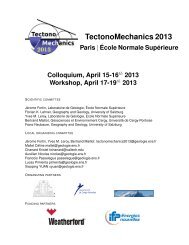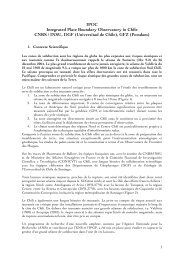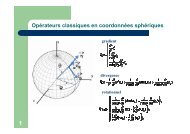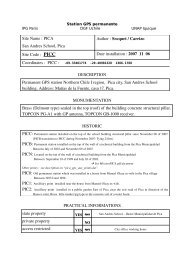PDF file - Laboratoire de Géologie de l'Ecole normale supérieure - Ens
PDF file - Laboratoire de Géologie de l'Ecole normale supérieure - Ens
PDF file - Laboratoire de Géologie de l'Ecole normale supérieure - Ens
Create successful ePaper yourself
Turn your PDF publications into a flip-book with our unique Google optimized e-Paper software.
MICROBLOCK ROTATIONS IN SULAWESI, INDONESIA<br />
more fully un<strong>de</strong>rstand this process, a more precise<br />
<strong>de</strong>scription of these microblocks’ motions and a better<br />
un<strong>de</strong>rstanding of the main active structures of the area<br />
are necessary. The purpose of this paper study is to<br />
<strong>de</strong>fine the <strong>de</strong>formation of the Sulawesi area utilizing<br />
geo<strong>de</strong>tic and seismological data. Using a <strong>de</strong>ca<strong>de</strong> of GPS<br />
measurements, we estimate the kinematics and likely<br />
boundaries of the micro blocks. We also examine the<br />
active faults of Sulawesi (e.g. Palu-Koro and Gorontalo<br />
strike-slip faults) in <strong>de</strong>tail to quantify their interseismic<br />
behaviour and assess their contributions to seismic<br />
hazards. Toward these ends, we mo<strong>de</strong>l our GPS<br />
velocities and earthquake slip vector azimuths with a<br />
combination of rigid block rotations [Morgan 1968;<br />
Peltzer and Saucier, 1996] and elastic <strong>de</strong>formation due to<br />
locking on the faults separating the blocks [Okada, 1985,<br />
1992; Savage, 1983; Savage and Burford, 1973]. This<br />
simultaneous inversion results in Euler vectors <strong>de</strong>scribing<br />
rigid block rotation in addition to <strong>de</strong>gree of coupling on<br />
the faults.<br />
Geodynamic setting<br />
Present-day kinematics<br />
According to the Nuvel-1A plate motion mo<strong>de</strong>l, the<br />
triple junction of South-East Asia is a T-T-F (trenchtrench-fault)<br />
type between the Eurasian (or Sunda),<br />
Australian and Philippine Plates [DeMets, et al., 1990;<br />
1994] (Figure 1). The Australian and Philippine Plates<br />
subduct beneath the Eurasia (or Sunda) Plate at rates of<br />
75 mm/yr and 90 mm/yr respectively. The E-W trending<br />
Australia – Philippine Sea / Pacific boundary zone that<br />
extends from eastern Indonesia through New Guinea<br />
accommodates the relative plate motion by transpressive<br />
faulting and tectonic block rotation [Tregoning et al.,<br />
1998, 1999, 2000; Stevens et al., 2002; Wallace, et al.,<br />
2004]. GPS measurement in Indonesia have helped<br />
consi<strong>de</strong>rably to refine the plate kinematics of South-East<br />
Asia [Punto<strong>de</strong>wo et al., 1994; Tregoning et al., 1994;<br />
Genrich et al., 1996, 2000; Prawirodirdjo et al., 1997,<br />
2000; Michel et al., 2001; Bock et al., 2003]. In<br />
particular, GPS velocities revealed that the Eurasian Plate<br />
does not inclu<strong>de</strong> South-East Asia, but instead the<br />
separate Sunda plate moves at about 10 mm/yr eastward<br />
relative to Eurasia [Chamot-Rooke and Le Pichon, 1999;<br />
Michel, et al., 2001; Simons, et al., 1999]. Studies based<br />
on <strong>de</strong>nser GPS arrays in Sulawesi reveal even finer <strong>de</strong>tail<br />
on block-like motions, for example rapid clockwise<br />
rotation of the northern part of the Sulawesi Island,<br />
named the Sula Block, with respect to the Sunda Block<br />
[Walpersdorf et al., 1998a, 1998b; Stevens et al., 1999].<br />
The latest study, based on 100+ sites in SE Asia, shows<br />
that <strong>de</strong>formation affects both the East Borneo and<br />
Sulawesi areas, while southern Sulawesi in particular,<br />
also moves in<strong>de</strong>pen<strong>de</strong>ntly of the Sunda Plate [Simons et<br />
al, sub]. These studies show that Sulawesi is clearly not a<br />
2<br />
Figure 1: Structural map of the Sunda – Australia –<br />
Philippine - Pacific Plates junction area. Arrows <strong>de</strong>pict the<br />
far field velocities of the plates with respect to Eurasia.<br />
Fault traces adapted from Hamilton (1979).<br />
part of the Sunda plate, but instead is itself broken into<br />
multiple micro-blocks accommodating complex<br />
<strong>de</strong>formation.<br />
Regional active structures<br />
The active structures of the Sulawesi area show<br />
complex patterns of faulting [Hall, 2002; Hall and Wilson,<br />
2000]. The Sunda plate is boun<strong>de</strong>d to the south by the<br />
Sunda-Banda arc which is associated with the northward<br />
subduction of the Australian Plate. Subduction of the<br />
Australian Plate at the Java Trench evolves into collision<br />
with Australia along the Timor Trough south of Sulawesi<br />
[McCaffrey and Abers, 1991]. Highly oblique<br />
convergence (~110 mm/yr) between the Pacific (or<br />
Caroline after [Weissel and An<strong>de</strong>rson, 1978]) and the<br />
Australian Plates is accommodated in western New<br />
Guinea where shortening and left-lateral shear are<br />
distributed among several tectonic boundaries [McCaffrey<br />
and Abers, 1991; Punto<strong>de</strong>wo, et al., 1994; Stevens et al.,<br />
2002]. Faults in New Guinea continue to the west to the<br />
Seram Trough and to the Sula-Sorong Fault that continues<br />
into Sulawesi. In the Philippines, the oblique convergence<br />
between the Sunda and Philippine Plates is accommodated<br />
by partitioning of the slip between the Philippine trench<br />
and the Philippine fault [Aurelio, 2000; Fitch, 1972]. The<br />
Manillia-Philippine trench system un<strong>de</strong>rgoes trenchnormal<br />
convergence [Rangin, et al., 1999] while leftlateral<br />
strike-slip is taken up on the Philippine Fault<br />
[Barrier, et al., 1991].<br />
The central part of the South-East Asia triple junction<br />
coinci<strong>de</strong>s with Sulawesi (Figure 2). The northern part of<br />
the island, is colliding with the Sunda Plate [Rangin,<br />
1989; Silver, et al., 1983; Silver, et al., 1983]. This<br />
relative motion is accommodated by left-lateral strike-slip<br />
motion along the Matano / Lawanopo Fault (the western






